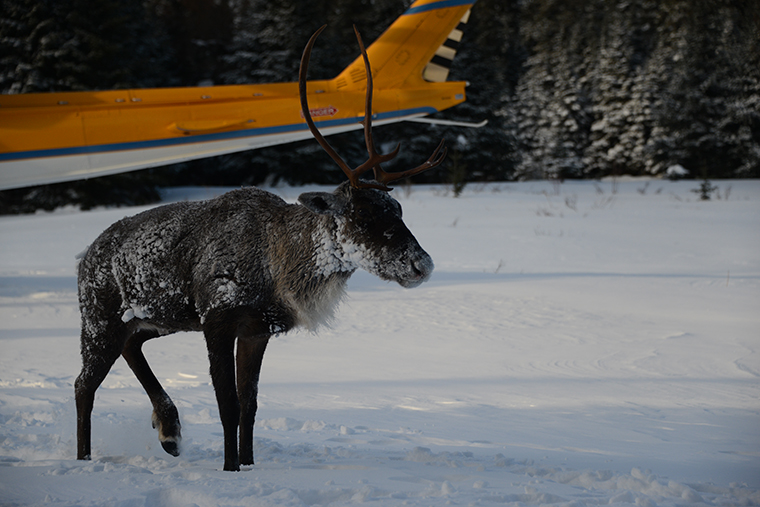
Photos and video provided by the MNRF.
The Ministry of Natural Resources and Forestry (MNRF) put its plan to relocate the depleting herd of caribou on Michipicoten Island into action over the weekend.
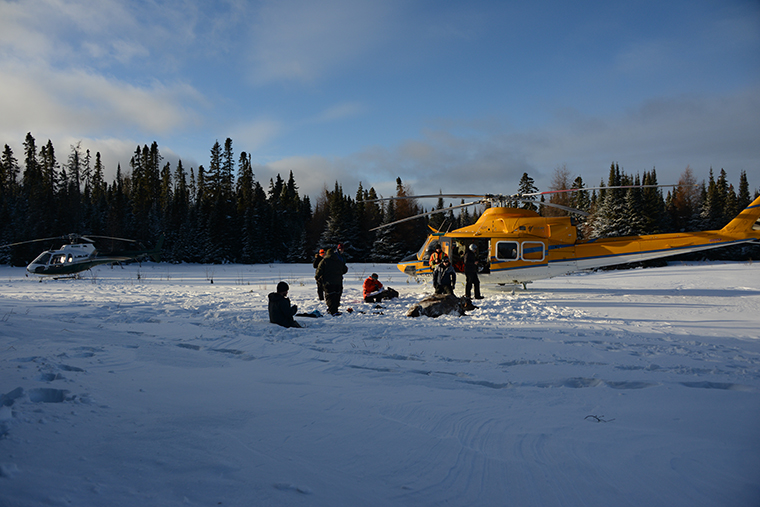 By Sunday evening a total of seven caribou, one of which was a bull, had been moved from Michipicoten Island, located about 65 kilometres southwest of Wawa in Lake Superior, to the Slate Islands. The Slate Islands are approximately 130 kilometres north of Michipicoten Island.
By Sunday evening a total of seven caribou, one of which was a bull, had been moved from Michipicoten Island, located about 65 kilometres southwest of Wawa in Lake Superior, to the Slate Islands. The Slate Islands are approximately 130 kilometres north of Michipicoten Island.
Four caribou were successfully moved by helicopter on Saturday and three on Sunday before operations had to be shut down for the day due to weather. Maimoona Dinani, spokesperson for the MNRF has confirmed crews are continuing to work throughout Monday, Jan. 14.
“We’ll continue to take two to four at a time and move as many as we can,” said Dinani. “We had a busy weekend and are pleased with how the translocation is progressing. We will be continuing our efforts throughout the day to relocate caribou to the Slate Islands.”
How long the crew will be there, however, is not clear. “This is a challenging situation that depends on a number of factors including weather and important safety considerations for both our staff and the caribou,” said Dinani.
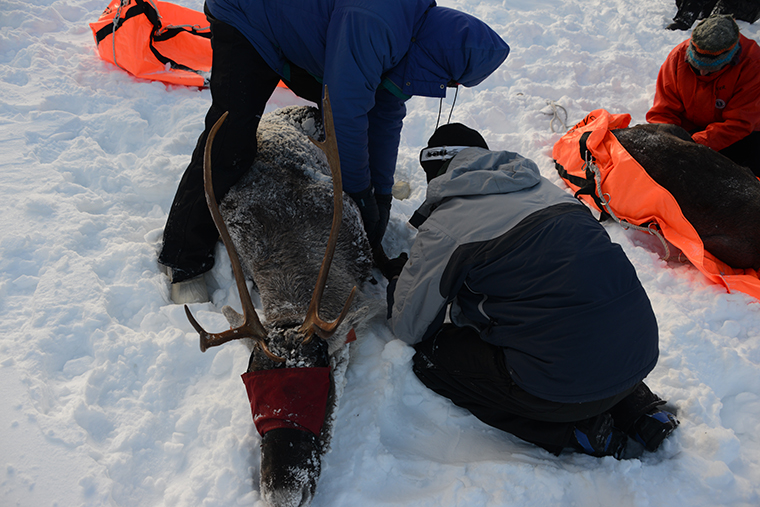 According to a protocol obtained by the Canadian Press, a helicopter hovers several metres above the ground to herd and target the caribou. A member of the capture crew in the helicopter fires a specialized “net gun” at the back of the animal with the hopes that the animal’s legs will be tangled in the net.
According to a protocol obtained by the Canadian Press, a helicopter hovers several metres above the ground to herd and target the caribou. A member of the capture crew in the helicopter fires a specialized “net gun” at the back of the animal with the hopes that the animal’s legs will be tangled in the net.
Once downed, the animal’s legs are tied together, earplugs and a blindfold are put in place and if the caribou is deemed healthy by a vet and handler, it is collared, sedated, and placed into a type of full body bag that allows the head to stay out.
Dinani said it takes anywhere from three to three and a half hours to complete a single trip, this includes loading and unloading the animals.
A vet on the other end reverses the sedation and monitors the animals while they recover.

The government first announced its plan to move the herd in early December and has been publicly criticized by Michipicoten First Nation Chief Patricia Tangie for not moving the animals sooner.
According to Dinani, the government has been working closely with Michipicoten First Nation members throughout the planning process. “On Friday, MNRF helicopters brought members of the Michipicoten First Nation to the Island for a traditional ceremony. We will continue to keep them involved,” says Dinani.
Wolves are the cause of the herd’s decimation. They came to the island in late 2013 and early 2014 via an ice bridge and have been feasting on caribou since. A 2011 survey of the herd showed 680 caribou on the island. Last year, there were only 120 caribou and about a dozen wolves.


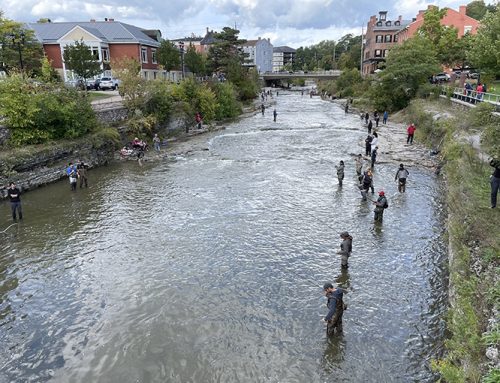
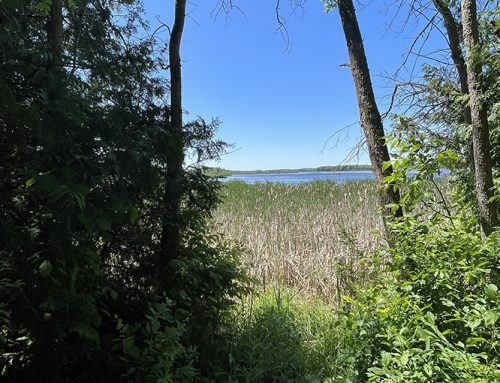


Is the mnr planning to relocate mountain caribou to area 21a
Why are so few journalists picking up on the underlying story here? Starting in 2015, the MNRF ran an experiment on a critical population of a threatened species which went horribly wrong. They did it without consultation with the people of Ontario or First Nations. When it went south (indeed it did, rapidly) they made you pick up the bill. They captured, collared, and released the four wolves which
originally arrived on Michipicoten Island, thereby actively engaging in wildlife research. They spent countless dollars flying out to the island capturing and collaring wolves and recollaring caribou as they
died. While looking for a “balance” which will never appear (look it up, the “Balance of Nature” is thoroughly a myth) the caribou population crashed. The academic literature is soaked with heavily cited, peer-reviewed publications which predicted what would happen; ignored.
The population starts at less than 10 animals in 1983, then grows as an uninterrupted exponential for 30 years. Unlike many journalists who take the press releases the MNRF hands them without question, Ms. Scott-Clarke gets the numbers correct here: By 2011, 680 animals existed on the island. By the time the wolves arrived a couple of years later, that number would have been well, well over 700
considering that at no time was there any indication the carrying capacity of the island had been approached. From 2013/2014 until now, that caribou population went from >700 animals to 30 or less. Ask the MNRF for the radio collar data; just try to pry it out of them. It tells the truth: It’s the gold-standard which shows how dramatically the population tanked, and how they knew. Check out the
2:10 pm time slot here:
https://web.archive.org/web/20170905050646/http://twsconference.org/sessions/conservation-and-ecology-of-mammals-carnivores/
Nothing else on that island changed. Out comes Arthur Rodgers, the guy in the blue jacket in the above pictures, and exclaims this to the Toronto Star on the 11th:
“Eason and Lepiano are concerned the wolves could wipe out the remaining caribou on Michipicoten Island, but Rodgers isn’t so sure the wolves are to blame.
‘There’s no scientific evidence…there’s just correlation, which is not causation,’ he said.”
Just what, dear Dr. Rodgers, what would evidence for causation look like in your world, exactly? Is it seeing each and every caribou being consumed by wolves?
These are the folks managing your wildlife.
Did I mention that all the while that the above was transpiring, quietly, while nobody noticed, caribou were functionally extirpated from the Slate Islands by wolves after over 100 years of presence? The MNRF told nobody; as I understand it, even the town of Terrace Bay, for which the caribou represent a significant economic input, was not told its goose which lays the golden eggs was terminated. No backup populations, no plans, no nothing – for a threatened species, in a provincial park. Two fully independent caribou populations eliminated at the same time; collared, studied, photographed, recorded for posterity. Good job, Ontario. 2018 is election year.